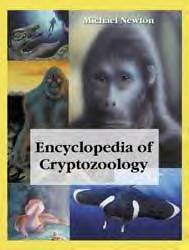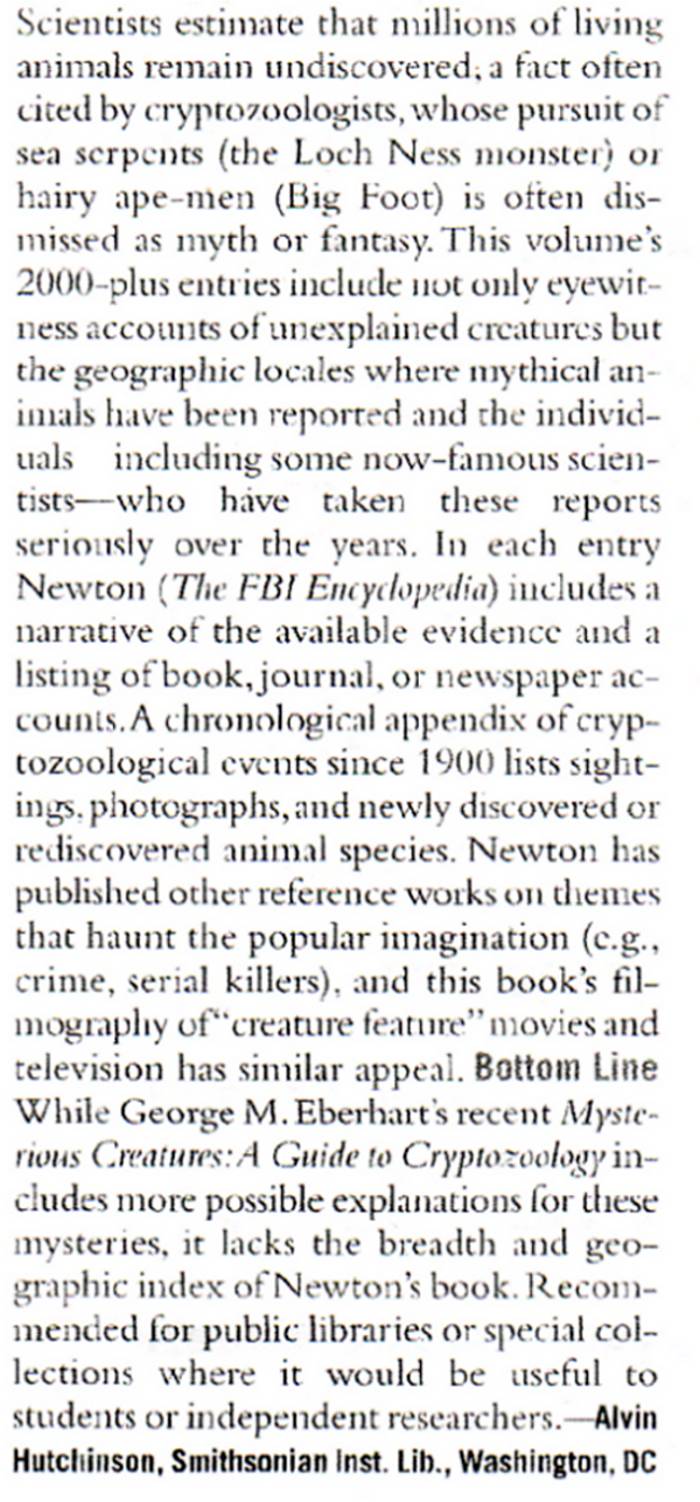I've received a copy today, and agree entirely with the above comments if you are interested in cryptozoology, you have to have this excellent, comprehensive encyclopedia. A thoroughly superb, informative, and fascinating work, to read from cover to cover, to consult for scholarly opinions and well-researched overviews, or simply to dip into as you wish. Well done, Michael, for producing a magnificent contribution to the cz literature that will remain a major
source of reference indefinitely, and which includes, btw, a wealth of wonderful illustrations by Bill Rebsamen - surely the Audubon of cryptozoology.
I received Michael Newton's Encyclopedia of Cryptozoology, late yesterday.
I will be writing a formal, published review, but I want to alert you to how
good it is. You should go out of your way to highly recommend it for
purchase by your local school or university library (the target audience
of a reference work like this). And for those serious cryptozoologists
who can afford it, for your personal research library, it, simply put, is a
*must* buy.
Last night, I couldn't help myself, and stayed up until the wee hours of
the night, reading, flipping, reading more, surfing, reading, and smiling.
What a trip. Newton's got it down pat. Critical writing with a light hand and
open-mindedness to looking at all facets, in presenting cases, cryptids,
and evidence, as well as the overturning of media-driven hoax claims (Nessie,
Surgeon Photos, Ray Wallace fiasco, and others). Most surprising of all
the entries I have read so far is Newton's reexamination of the supposed 1990
expose' of Three-Toes, with a fresh look again at "all" elements of those
1948 events. This volume quite correctly is as skeptical of blanket
debunking claims as it is to the fast rush to specific cryptozoological
hypotheses. Newton logically critiques the various theories of
cryptozoologists who have ventured forth with their thoughts. His
discussion of the Minnesota Iceman, for example, in its total fairness to
several points of view, I found amazing.
There are 2,744 entries, including 112 individual biographies, 77
cryptozoology groups described, and, of course, lots of location data,
cryptids detailed, and illustrations sprinkled throughout. It also has
some fantastic appendices that are comprehensive listings of new animal
discoveries, cryptofiction, cryptozoology in films, and cryptozoology on
television. At 576 pages in one oversized volume, it is a rather user
friendly reference work.
The Encyclopedia of Cryptozoology, a Global Guide to Hidden Animals and Their Pursuers" by Michael Newton, is an eye opening publication, and long overdue. It sets the record straight and serves as a worthy resource to expand the knowledge of anyone interested in this field. Within the first seven pages Michael Newton convincingly illustrates the important roll of the frequently ridiculed field of study, Cryptozoology.
His observations that "the days of exploration and discovery are not behind us..." compels the reader to delve further into the Encyclopedia of Cryptozoology to see what wonders may await. A fitting quote from Einstein kicks off the journey, and what a journey it is.
Read about fantastic creatures that may exist, including the famous Bigfoot, Sasquatch, Yeti and other unknown hominids, the Loch Ness Monster and a variety of Lake Monsters from around the world. And that's not all, there's room for other mysteries like Alien Big Cats, a new species of owl, giant turtles, a six foot platypus, giant armadillos, mislocated alligators, and of course the infamous Chupacabra. But these are just a small fraction of what The Encyclopedia of Cryptozoology contains.
As an encyclopedia this book offers more than previously undiscovered and currently unknown animals, it contains detailed information on the people, places and organizations that are part of the colorful history of Cryptozoology. It also contains a share of speculative entries with nothing more than unconfirmed reports to support the story, but Cryptozoology is about the unknown and having an open mind, so let's not let such technicalities stand in the way of a good possibility.
Many great books have been written about Cryptozoology and its various cryptids, as these mystery creatures are known, but this massive volume is long overdue. It has it all, a great introduction to Cryptozoology and comprehensive entries for every reported cryptid from as far back as the 8th century, all presented in a fine looking, large, hardbound edition that sports more than 580 pages, and over 350 photographs and illustrations.
The Encyclopedia of Cryptozoology is a must have for anyone interested in learning more about mystery monsters and unknown creatures from around the world. It comes highly recommended by this lover of the strange and curious.











